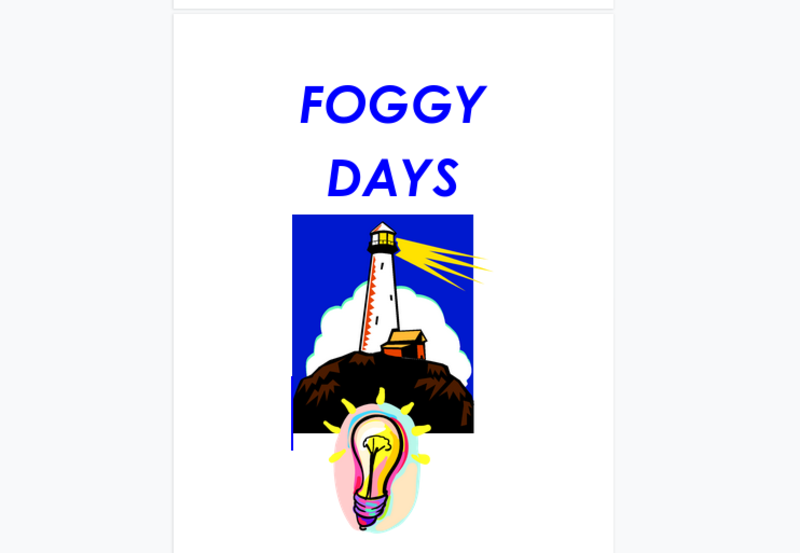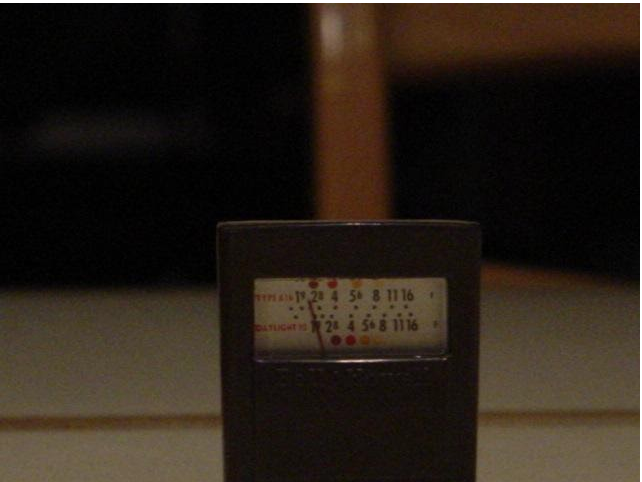Sunday, January 31 2021
from the homework vault: 8th grade science fair

Remember the science fair? What a stressful time. Nothing compared to the anxiety of picking a project, gathering supplies, writing a research paper, and presenting a board in the gym. The stress seemed to loom over me for the entire year.
On top of everything, the school science fair was a sore spot for my personal pride. Between me and my two sisters, I was always the left-brained one. I was better with things like computers, math, and engineering. Yet every year I'd strike out at Science fair season. My sisters both won awards and received invitations to regionals and the state science fair. For all four of the projects I slaved over, I received absolutely no accolades. I don't even think I scratched an A-.
For this particular project, I had the hair brained idea of testing how strongly different colors of light can shine through fog. The light meter I borrowed from our school's physics teacher looked like an artifact from World War I, and reading my results it's pretty clear that I didn't understand how it worked. I locked myself in the darkest room in our basement with an old goldfish tank filled with watered down milk and a novelty keychain flashlight from my dad's work.
Acknowledgments
I would like to thank the IJAS for hosting this wonderful event. I would also like to thank Mr. Gauger for his kind provision of his Bell and Howell light meter. I appreciate the help of my sister Kelly and my science teacher Mr. Stack.
Purpose
Which color of light will pass through fog and retain the highest illumination?
Hypothesis
If selective-yellow light has the longest wavelength, then it should pass through fog and retain the highest intensity.
Review of Literature
Aristotle first developed the theory of light traveling in waves. These light waves are composed of electric waves and magnetic waves (Mueller, p.31). The height of a wave is measured in amplitude, while the time in which a certain point in the wave takes to pass by is measured in wavelength (Hecht, p.3). The highest point in the wave is called the crest; the lowest point is the trough (Sobel, p.12). These light waves travel in a straight line and radiate from the light source in all directions (Hecht, p.8).
Although light waves travel in a straight line, various physical objects can hinder or redirect this path. Matter can absorb light and simultaneously reflect light (p.11). The most efficient way to reflect light is by the use of mirrors. The concave mirror, a mirror that is bent inward to form a caved-in surface, is used to reflect light to a certain focal point. This is used in satellites. A convex mirror, a mirror that is bulged the opposite direction of a concave mirror, can spread contacting light in all directions. Convex mirrors are used in building halls to see around corners (p.22). Light can also be transmitted. When light hits a transparent object, it is able to pass through (p.11).
The strangest of all these hindrances is refraction. A Dutch scientist named Willebrord Snell first answered the problem of refraction. He noticed that when an object was held halfway in water, it appeared to bend in shape. Not only that, but he also noticed that when the object was held vertically, there was no refraction that had occurred. To explain this, he speculated that when light rays hit the water at an angle, some of the light was reflected while the rest passed through the water. This delivered the optical allusion that the object is bending. However, the object does not appear to bend when held vertically because the reflected light rays travel along their same original path (Mueller, p.31).
Water is not the only physical object that can refract light. Lenses are used to intentionally bend light rays. The concave lens is caved in on both sides and is classified by optometrists to carry a negative effect, diverging passing light. Various forms of the concave lens include the double concave lens. This lens is bent equally inward on both sides. Another negative lens is the plano-concave. This lens is straight on one side, while the opposite side is bent inward. The third concave lens is the negative meniscus. It is slightly bent outward on one side while it is concave on the other. A convex lens is bent outward and is classified by optometrists to carry a negative effect. It is mostly used to concentrate light to a certain point. One form of the convex lens is the double convex. It is equally bent outward on both sides. The second form is the plano-convex. It is level on one side while it is curved outward on the other. The final type of convex lens is the positive meniscus. It is slightly concave on one side and convex on the opposite side (Hecht, p.25-29).
Isaac Newton first discovered the visible spectrum when he put a spectroscope in front of a thin beam of sunlight. He then also proved that light, along with being able to be separated, could also be re-assembled back into white light. He assured this when he put a second spectroscope to the colored bands (Mueller, p.33).
At the center of the electromagnetic ray lies the visible spectrum. This is the only piece of the electromagnetic wave that can be seen with the human eye. The visible spectrum consists of seven different bands of colors. They are red, orange, yellow, green, blue, indigo, and violet. Although they are all visible to the human eye, they each have different wavelengths. Red has the longest wavelength, and violet has the shortest (Hecht, p.4).
Although the visible spectrum contains several colors, it is only a small sliver compared to all the invisible light that is constantly occupying our very own atmosphere. On the longer wavelength side, there are three more bands. Radio waves, the rays with the longest wavelength, are used all over the world to communicate messages through radio antennas and transmitters. Microwaves are used in modern day kitchen appliances to heat food in a fast, efficient way. Right after the microwaves are the infrared waves. These waves are used to sense heat (Hecht, p.4).
On the shorter wavelength side, there are three more bands. The ultraviolet rays, following violet, can actually be a harmful light. Ultraviolet rays, or UV rays, are what cause sunburn and skin cancer. Following ultraviolet are x-rays. X-rays are used in hospitals to detect bone fractures and other anatomical problems without surgery. The final bands of light in the electromagnetic spectrum are the gamma rays. Gamma rays have the shortest wavelength. They are used for cancer treatment in hospitals (Hecht, p.4).
Fog is actually composed of miniscule water droplets known as water vapor. When light hits these individual droplets, it scatters (just as in Sir Isaac Newton’s earlier experiments with his spectroscope). There are a number of reasons why fog makes navigation so difficult. When the light rays scatter off the water vapor, a phenomenon known as dispersion occurs. In a result to dispersion, the light rays are redirected from the road and cause the overall scene to be darker. Another reason is that when the rays disperse, some will reflect back into the driver’s eyes, causing glare.
To solve this problem, fog lights need to be made one color. If white is shone into fog, all the colors of the spectrum will disperse into completely different directions because they all have different wavelengths. This color must have a longer wavelength because it brings about less dispersion than colors with a shorter wavelength. This is why modern automobile fog lights are made yellow. Yellow supposedly meets all these requirements (Barrans, [Online]). This type of light that has been modified for fog penetration is called selective-yellow light. However, light with a yellow filter can reduce its own intensity by 12 % (Stern, [Online]). Light is a beneficial and fascinating concept that should be understood. Where would we be without it?
Materials
- One 28 by 22 centimeter sheet of red, orange, yellow, green, blue, and purple translucent paper
- One 4 D-cell Maglight flashlight
- One measuring cup
- 15 milliliters of 2% organic reduced fat milk
- 1 liter of tap water
- One 16.51 by 11.43 by 8.3 centimeter plastic transparent fish tank
- One Bell and Howell model 72 light meter (or equivalent)
Methods of Procedure
- Pour 15 milliliters of milk from the measuring cup into the plastic fish tank.
- Pour 1 liter of tap water of from the measuring cup and into the fish tank.
- Set the fish tank (now filled with a milk and water mixture) on a level table in a completely dark room.
- Turn the fish tank so that the side measuring 8.3 centimeters is facing toward you.
- Set the various colors of translucent paper nearby in spectrum order (with red on top and purple on the very bottom of the stack).
- Place the Maglight flashlight to the right of the fish tank with the front of the flashlight pressed up to the side of the fish tank.
- Place the light meter to the left of the tank with its light-sensitive side also pressed up against the side of the fish tank.
- Switch the flashlight on and record the results shown by the light meter.
- Take your first translucent sheet of paper and slip it between the flashlight and the fish tank wall. Record the results.
- Replace the paper with the next translucent sheet of paper and record the results shown by the light meter.
- Repeat step 10 until you have recorded the results of all seven translucent pieces of paper.
Variables
In this experiment, there were independent, dependent, and controlled variables. There was also a control group. Color was the independent variable. Light intensity was the dependent variable. Lighting, light source intensity, the angle of light contact with the interference, the interference mixture, and the thickness of the colored paper were the controlled variables. White light was the control group.
Results
The white light proved to be just below a 4. Red light caused a reading that was a bit higher than the halfway point between 19 and 28. Orange light proved to be a 28. Yellow light was a just above a 28. Green light was a 19. Blue light was just above a 28. Finally, purple light was above a 19.

This is the scale that was used in the experiment (the set of numbers positioned on the lower section of the meter).
Conclusion
The results in the experiment did not support the hypothesis. Although yellow light contained less glare then white light, its overall intensity was significantly reduced by the color filter. This may have been the reason why all the individual colored lights were much less bright than the white light. The white light may have retained the highest intensity because it was not reduced by a color filter. The light intensity is more effective in fog penetration than light color. However, the color filters used in this experiment may have been too thick and may have contributed to the reduced intensity in several colors. Perhaps a transparent filter of the same type should have been used as a control group for white light. Thinner filtering paper would have also been a better selection.
References
Barrans Jr., Richard. “Fog Lights”. [Online]. Newton. Available: http://www.newton.dep.anl.gov/askasci/phy99/phy99xx4.htm [2004, Nov. 1]
Hecht, Jeff. (1987). Optics: Light for a new age. New York, NY: Jeffery Hecht.
Mueller, Conrad. (1966). Light and vision. Morristown, NJ: Silver Burdett Company.
Sobel, Michael. (1987). Light. Chicago: The University of Chicago Press.
Stern, Daniel. (2003). “What is selective-yellow light?” [Online]. Daniel Stern Lighting. Available: http://www.danielsternlighting.com/tech/lights/light_color/light_color.html